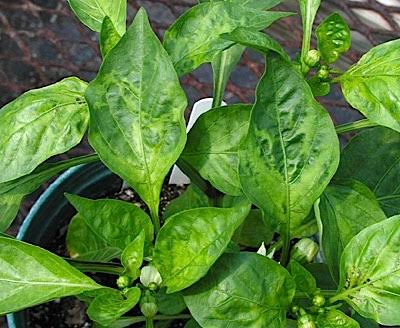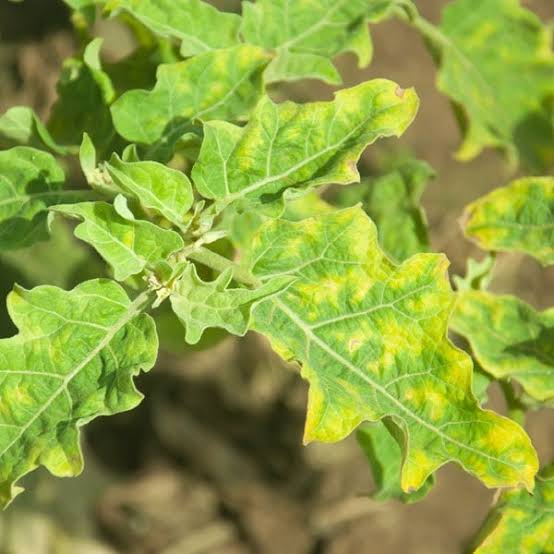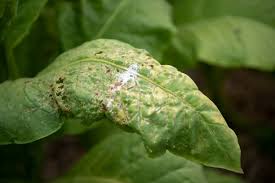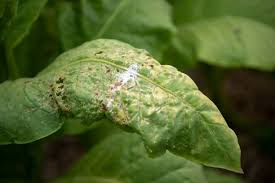Tobacco mosaic virus (TMV), scientifically known as Tobamovirus group member, is a microscopic pathogen that affects plants, particularly tobacco and other members of the Solanaceae family. This virus is like a tiny invader that can cause significant harm to crops, leading to economic losses for farmers.
Picture TMV as a sneaky troublemaker that you can’t see without a powerful microscope. It doesn’t care about the size of the plant; it just wants to wreak havoc. The name “Tobacco mosaic virus” comes from the mosaic-like patterns it creates on infected leaves. It’s like nature’s own abstract art, but with consequences.
Now, let’s talk about how this virus operates. It’s a master of disguise, using its genetic material to infiltrate plant cells. Once inside, it starts making copies of itself, spreading like wildfire within the plant. The infected cells start showing symptoms, forming those distinctive mosaic patterns on the leaves. It’s as if the virus is leaving its mark, saying, “I’ve been here.”
Think of TMV as a plant detective’s nightmare. It can spread in various ways – through contaminated tools, seeds, or even by the tiny insects that munch on infected plants. It’s a cunning infiltrator, always finding new routes to make its presence known.
But why should we care about this invisible villain? Well, it’s a big problem for farmers. Infected plants lose their vitality, and their leaves become discolored and distorted. This means less healthy crops and, ultimately, less food on our tables. TMV doesn’t discriminate; it affects plants we rely on, like tomatoes, peppers, and, of course, tobacco.
Scientists and farmers work together to find ways to battle this tiny troublemaker. They explore strategies like using resistant plant varieties or employing good old-fashioned hygiene practices to prevent the virus from spreading. It’s like a never-ending game of cat and mouse between humans and TMV.
Understanding the Tobacco mosaic virus is like deciphering the secret language of plants and viruses. It’s a microscopic drama playing out in our gardens and fields, reminding us that even the tiniest creatures can have a big impact on our world. So, next time you see a mosaic pattern on a plant, remember, it might be the subtle signature of the elusive Tobacco mosaic virus.
Read Also: Why Are Honey Bees Important
Plants Affected by Tobacco Mosaic Virus (Tobamovirus)

Tobacco mosaic virus (TMV) is an equal-opportunity invader, affecting a wide range of plants. It doesn’t play favorites; if a plant is susceptible, it becomes a potential victim to this microscopic troublemaker.
Consider tobacco as the primary target – it’s in the virus’s name, after all. Tobacco plants often bear the brunt of TMV’s impact, experiencing stunted growth, distorted leaves, and that characteristic mosaic pattern. But TMV doesn’t stop there; it has a penchant for spreading its influence across different members of the plant kingdom.
Tomatoes, another popular plant in gardens and farms, are also on TMV’s hit list. Imagine the disappointment of a tomato farmer seeing their prized fruits affected by this invisible menace. The virus can cause tomato leaves to curl and discolor, compromising the health of the entire plant.
Peppers, both sweet and hot varieties, are not spared either. TMV infiltrates pepper plants, causing leaf mottling and affecting the overall yield. It’s like the virus has a knack for transforming vibrant green leaves into a mosaic of disease.
Not stopping at these kitchen staples, TMV extends its reach to other members of the Solanaceae family, such as eggplants. These glossy purple vegetables can become hosts to the virus, experiencing similar symptoms like leaf distortion and mosaic patterns.
Beyond the Solanaceae clan, TMV doesn’t discriminate – it has been reported to infect a variety of plants including cucumbers, beans, and even flowers like petunias. This means that ornamental plants in gardens may fall victim to the virus, disrupting the beauty we aim to cultivate.
The scope of TMV’s influence underscores the importance of vigilance and proactive measures in agriculture and horticulture. Farmers and gardeners alike must be aware of the potential risks, employing strategies to prevent the spread of TMV and protect the diverse array of plants that enrich our surroundings. So, whether it’s in the field, the garden, or the greenhouse, the Tobacco mosaic virus is a relentless adversary, reminding us of the delicate balance in the world of plants.
Damages Caused by Tobacco Mosaic Virus

The damages caused by the Tobacco mosaic virus (TMV) are akin to a silent invasion, leaving a trail of destruction in its microscopic wake. This tiny troublemaker wreaks havoc on plants, resulting in various detrimental effects that can have significant consequences for agriculture and horticulture.
One of the most noticeable impacts is the distinct mosaic-like patterns that appear on the leaves of infected plants. It’s like nature’s way of signaling that trouble is brewing. These patterns, however artistically intriguing, are a clear sign that something is amiss within the plant. The infected leaves may become distorted, and the overall appearance of the plant is compromised.
Stunted growth is another common consequence of TMV infection. The virus interferes with the normal development of the plant, hindering its ability to reach its full potential. This can be particularly problematic for crops grown for commercial purposes, as it directly translates to reduced yields.
The virus doesn’t stop at visual disruptions; it can also impact the quality of the affected plants. For instance, in crops like tobacco, which is highly susceptible to TMV, the quality of the leaves can be severely compromised. This not only affects the economic value of the crop but also poses challenges for industries dependent on high-quality raw materials.
Furthermore, TMV-induced damage extends beyond just one growing season. The virus can persist in plant debris and soil, posing a threat to subsequent crops. This persistence makes managing and preventing the spread of TMV an ongoing challenge for farmers.
In addition to the direct effects on plants, TMV can have indirect consequences on the economic and environmental aspects of agriculture. Crop losses, reduced quality, and the need for preventive measures can lead to increased production costs for farmers. Moreover, the reliance on pesticides and other control methods raises environmental concerns.
The damages caused by the Tobacco mosaic virus go beyond mere visual disturbances on leaves. They encompass a spectrum of effects, including distorted growth, reduced yields, compromised plant quality, and long-term challenges for sustainable agriculture. Understanding and addressing the impact of TMV are crucial for maintaining the health and productivity of plants in the face of this microscopic menace.
Read Also: How Do Honey Bees Make Honey
Control and Preventive Measures

Controlling and preventing the spread of the Tobacco mosaic virus (TMV) requires a combination of proactive measures and careful management practices. Farmers, gardeners, and researchers employ various strategies to curb the impact of this microscopic troublemaker. Here are some key control and preventive measures:
1. Use Resistant Varieties: Selecting plant varieties that show resistance to TMV is a crucial first step. Breeding and cultivating plants with inherent resistance can significantly reduce the likelihood of infection.
2. Strict Hygiene Practices: TMV can easily spread through contaminated tools, hands, or clothing. Implementing strict hygiene measures, such as regularly cleaning and disinfecting equipment, helps prevent the inadvertent transmission of the virus.
3. Isolation and Quarantine: If TMV is detected in a particular area, isolating infected plants and implementing quarantine measures can help contain the spread. This is akin to putting the infected plants in a “time-out” to prevent the virus from reaching healthy ones.
4. Vector Control: TMV can be transmitted by insects like aphids. Controlling these vectors through insecticides or natural predators can help minimize the risk of virus transmission from one plant to another.
5. Seed Testing and Certification: Ensuring that seeds are free from TMV is crucial for preventing its introduction into new areas. Seed testing and certification programs help maintain the quality of planting material.
6. Avoiding Overhead Irrigation: TMV can be transmitted through water. Avoiding overhead irrigation and using drip systems can reduce the likelihood of water-borne transmission.
7. Education and Awareness: Educating farmers, gardeners, and agricultural workers about the symptoms of TMV and the importance of preventive measures is vital. Increased awareness can lead to early detection and prompt action.
8. Crop Rotation: Implementing crop rotation practices helps disrupt the virus’s life cycle. Moving to non-host crops in between susceptible plantings can reduce the risk of TMV buildup in the soil.
9. Monitoring and Early Detection: Regularly monitoring plants for symptoms of TMV and implementing early detection measures enable swift action to contain the spread. This might involve routine field inspections or the use of diagnostic tools.
It’s a collaborative effort that involves scientific research, informed decision-making, and a commitment to maintaining a resilient and disease-resistant agricultural environment.
Frequently Asked Questions (FAQs) About Tobacco Mosaic Virus (Tobamovirus)
1. Q: What is Tobacco mosaic virus (TMV)?
A: TMV is a microscopic virus that primarily affects plants, causing distinctive mosaic patterns on leaves. It can impact a wide range of plants, posing a threat to agricultural crops and ornamental plants.
2. Q: How does TMV spread?
A: TMV can spread through various means, including contaminated tools, hands, clothing, and insect vectors such as aphids. The virus can also be transmitted through infected seeds and soil.
3. Q: Which plants are susceptible to TMV?
A: TMV has a broad range of hosts, affecting plants like tobacco, tomatoes, peppers, cucumbers, beans, and more. It can infect members of the Solanaceae family, as well as various ornamental plants.
4. Q: What are the symptoms of TMV infection?
A: Infected plants often exhibit mosaic patterns on leaves, leaf distortion, stunted growth, and changes in color. Symptoms can vary depending on the plant species.
5. Q: Can TMV infect humans or animals?
A: No, TMV is specific to plants and does not pose a threat to humans or animals. It’s crucial to note that plant viruses, including TMV, cannot cause diseases in humans.
6. Q: How can TMV be controlled and prevented?
A: Control measures include using resistant plant varieties, practicing strict hygiene, isolating infected plants, controlling insect vectors, seed testing, and implementing genetic engineering. Early detection and awareness also play key roles in prevention.
7. Q: Is there a cure for TMV-infected plants?
A: Unfortunately, there is no cure for TMV-infected plants. Once a plant is infected, the focus shifts to prevention and management strategies to limit further spread.
8. Q: How long does TMV persist in the environment?
A: TMV can persist in plant debris and soil, posing a threat to subsequent crops. Proper sanitation and crop rotation are essential for managing the long-term impact of TMV.
9. Q: Can TMV be transmitted through water?
A: Yes, TMV can be transmitted through water. To reduce the risk of water-borne transmission, avoiding overhead irrigation and using drip systems are recommended.
10. Q: Are there ongoing research efforts to combat TMV?
A: Yes, ongoing research explores genetic engineering, new control methods, and understanding the virus’s biology. The goal is to develop more effective strategies for managing and preventing TMV infections.
Read Also: Why is it Often Easier to Start a Fitness Program Than it is to Maintain One?

